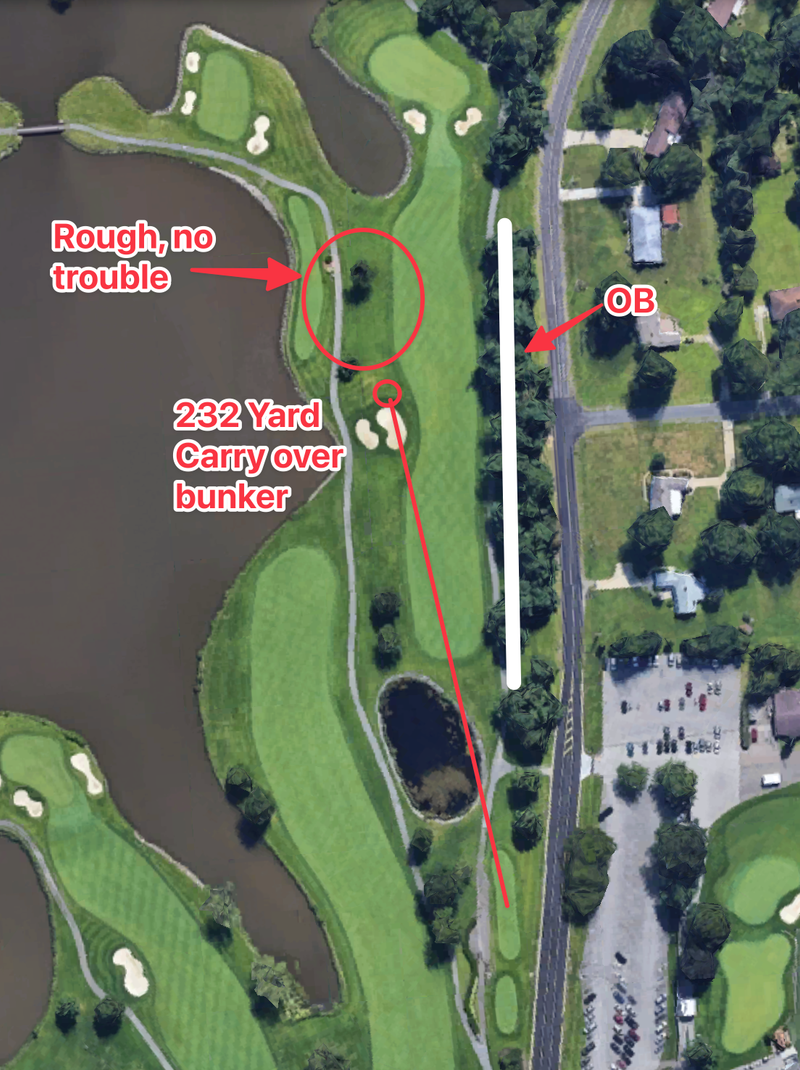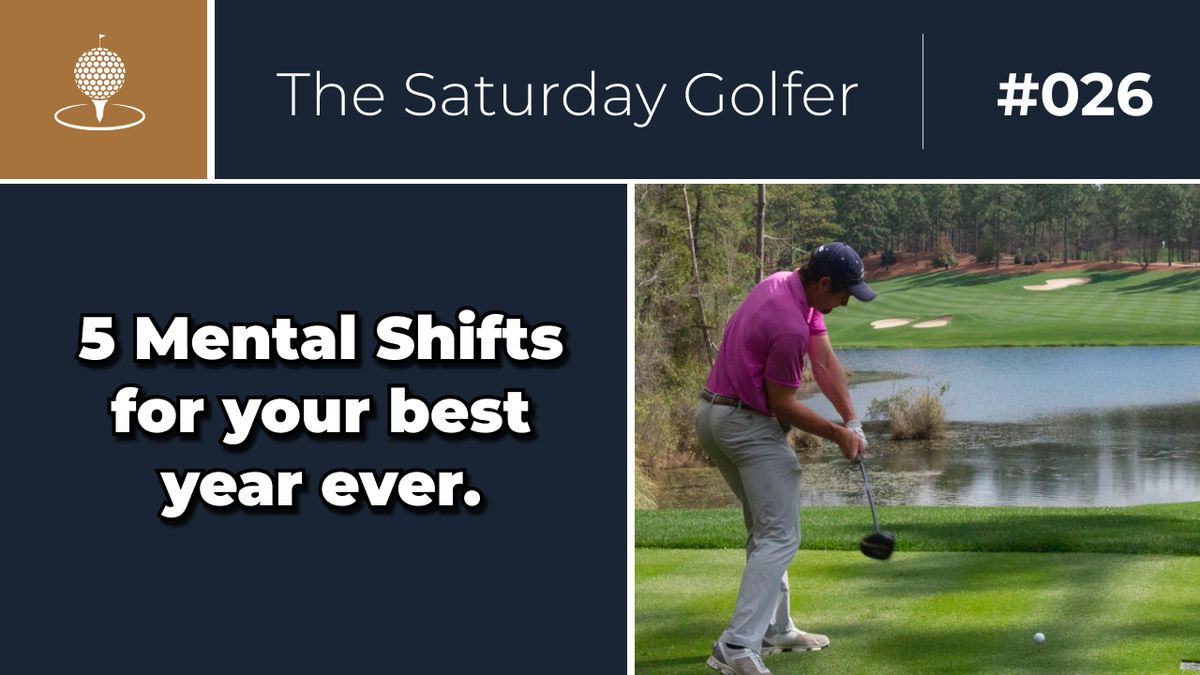As golfers, we often face a chicken or egg scenario—if we've never broken through a scoring barrier, how are we supposed to have the confidence to do so?
Do you get confidence from low rounds? Or do low rounds create confidence?
Unlike many types of skills, showing up every day and "practicing" golf doesn't always guarantee lower scores.
That's why today, we'll be looking at 5 mental game shifts that you can take into 2024.
Pick 2-3 of these and I guarantee your game will improve.
Let's dive in.
Mental Shift #1: What is the correct course strategy for your skill level?
All golfers should play the "optimal" strategy right?
Isn't this like a game of chess, where there's a "correct" way to play the game?
No. No, it's not.
Let's look at a scenario.
Where would you aim your tee shot on this par 4?

Below, I've listed the "recommended" play for golfers of different skill levels:
- 100s Golfers — aim 10 yards left of the left side of the fairway
- 90s Golfers — aim 5 yards left of the left side of the fairway
- 80s Golfers — aim at the left side of the fairway
- Scratch Golfers — aim just inside the left side of the fairway
Whoa there! You're telling me that I need to aim in the rough?
Yes, exactly.
Ideally, you'd aim in the rough and try to hit a small fade that ends back in the fairway.
When we look at this hole, we can make a few observations:
- There is OB along the right side of the fairway. If you hit it here, you take stroke AND distance, which is the most penalizing shot in golf.
- There is a pretty substantial "safe" area left of the fairway. Sure, you'll be in the rough; maybe behind that tree. But you won't be taking a penalty shot.
- Even if you manage to hook it 50+ yards left and hit it in the water left, this is still less penalizing than OB right (because you get to drop where the ball entered the water rather than re-teeing)
Why is the target different for each golfer?
Because better golfers generally have smaller shot dispersion patterns.
Ideally, we want to pick a target that keeps the likelihood of hitting it OB less than 5%. We'll never get that down to 0% and we shouldn't try. But we can alter our target to alter the likelihood of taking a huge penalty.
For scratch and pro golfers, aiming down the left side of the fairway will achieve that.
For most 100s golfers, if they aimed down the left side, their shot patterns would indicate that greater than 5% of those tee shots go OB. By adjusting their aim 5-10 yards left of the fairway, there's a reasonable likelihood they'll miss their target right (and end up in the fairway) and a reasonable likelihood they'll miss left (and end up in the rough).
While "grip it and rip it" with confidence is one way to play this game, it's also a good idea to evaluate where the trouble is and determine which areas of the golf course are most penalizing. By doing this, we can adjust our strategy to give ourselves the best chance of scoring well.
Mental Shift #2: Maybe you're not the "type" of golfer you think you are
I hear these a lot:
- "If I see my swing on video, I'll start overthinking"
- "If I hit on the range too much, I'll get worse"
- "New clubs help my confidence, so I replace them often"
- "I have to take lots of practice strokes to feel confident over my shots"
Go ahead, write down all the "assumptions" you have made about your golf game. Then, ask yourself—what if I did the opposite?
What if instead of taking lots of practice strokes, you took none?
What if instead of guessing what is wrong with your swing, you filmed it and identified the root cause of your missed shots?
Mental Shift #3: Get back to basics
If I wrote this same post for the next 10 years, I'd include this point on it every single time.
Heck, I'd bet 90% of you reading this could benefit from a "reset".
What would happen to your game if...
- You practiced your posture and alignment every day for the next 60 days
- You developed a pre-shot routine and stuck with it on every shot
- Instead of ripping driver, you worked on the core fundamentals of golf by hitting hundreds of basic pitch shots
Mental Shift #4: Every Shot Must Have a Purpose
Golf can be intimidating when you think of it as 80, 90, or 100 shots.
That's a lot of shots to get right!
Instead, think of golf as a single shot.
Unlike many other sports where the game continues at a fast pace whether you're ready or not, golf is a slow game. Between every shot, you can reset.
It's kind of like big projects at work—you can't work on "the project". You have to work on individual tasks that make up the project.
And the quality of the work you put into each task determines the quality of the overall project.
Golf is no different. The quality of each shot determines the quality of golfer.
If you've been around this site long enough, you'll notice that the title of this section is inspired by Every Shot Must Have a Purpose, one of my favorite golf mental game books of all time.
Mental Shift #5: Do you genuinely believe in yourself?
This one surprises a lot of golfers.
Let's say you're trying to break 80 for the first time.
Do you actually believe you can do it?
It's crazy how many golfers who consistently shoot 83 say... NO.
Sometimes, all it takes is a mindset shift from, "I've never shot in the 70s before" to, "I'm going to work on the most important parts of my game and shoot in the 70s by the end of this year".
So ask yourself—do you believe in you? If not, write down 2-3 tangible actions you can take to guarantee you start believing in your abilities out there on the course.
Final Thoughts
Going into 2024, I challenge you to choose 2 or 3 of these above and implement them in your game.
And if you can't decide, just go back to basics! No golfer ever got worse by working on the fundamentals that we rely on for every single shot.
